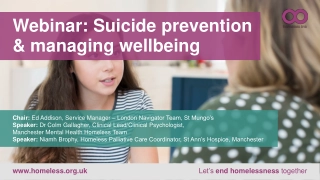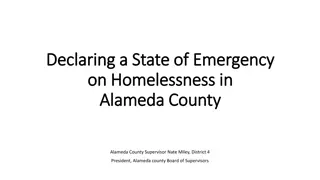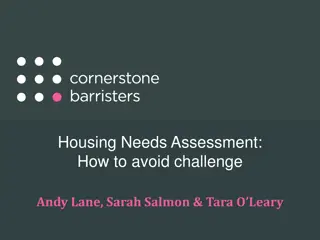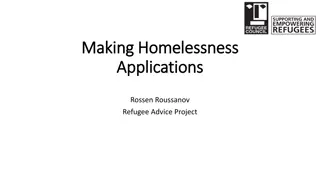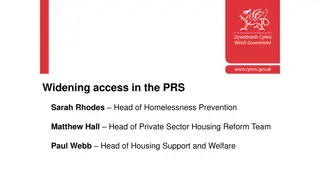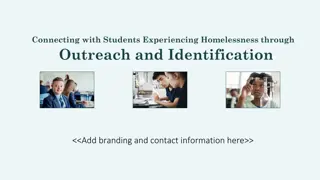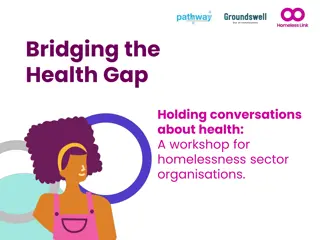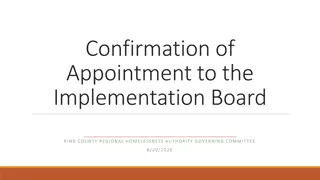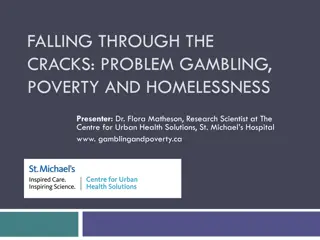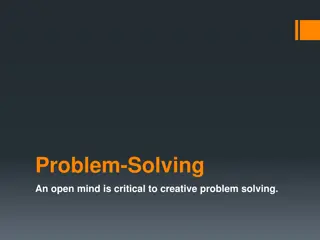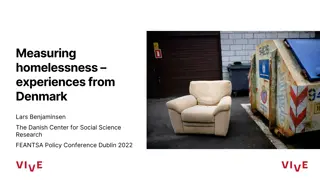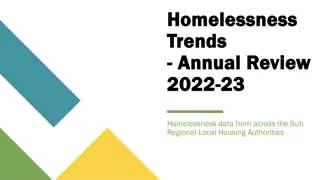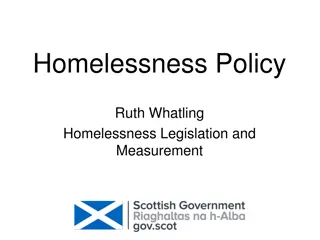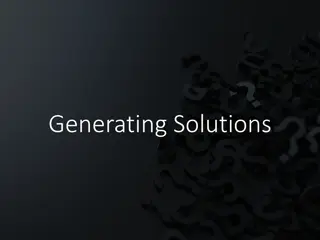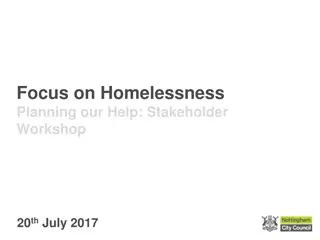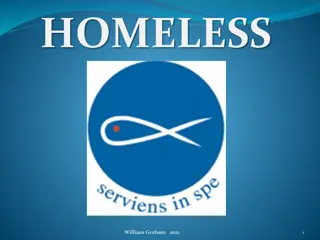Introduction to Problem Solving for Homelessness Prevention
Explore problem-solving strategies to address and prevent homelessness, focusing on rapid resolution and diversion methods. Learn how problem-solving differs from traditional prevention approaches and the benefits it brings to individuals and the system.
Download Presentation

Please find below an Image/Link to download the presentation.
The content on the website is provided AS IS for your information and personal use only. It may not be sold, licensed, or shared on other websites without obtaining consent from the author. Download presentation by click this link. If you encounter any issues during the download, it is possible that the publisher has removed the file from their server.
E N D
Presentation Transcript
Introduction to Diversion/Problem Solving Presenter: Katharine Gale Katharine Gale Consulting and Focus Strategies
This is one of five video trainings sponsored by the Washington Department of Commerce About This Series Each training will last 30 to 60 minutes Topics include a. Introduction to Housing First b. Introduction to Rapid Rehousing c. Introduction to Diversion/Problem Solving d. Landlord Engagement in Rapid Rehousing e. Progressive Engagement for Programs and Systems 2
Problem Solving Session Outline 1. What is Problem Solving? 2. Where does it happen 3. How do you structure the conversation 3
What is Problem Solving? A strategy and approach that addresses or prevents homelessness by helping people seeking assistance to: 1. Return immediately to housing 2. Without having to enter temporary shelter or a housing program 3. Utilizing safe and available permanent and temporary housing options. Other names for this practice: Diversion, Rapid Exit, Rapid Resolution, and Housing Counseling 4
Reasons to Implement Problem Solving Household is showing that they are in a crisis that is leading to homelessness Now Not enough resources - many hear No or Wait Problem Solving offers a Yes to help now Shelter has negative effects on people Not everyone will go to a shelter As long as it s safe, non-shelter keeps people in charge of driving their solutions Reduces stigma
Reasons to Implement Problem Solving For the system Saves shelter and housing programs for those who truly have no other options. Allows resolution at much lower cost. In some cases, preserves relatively more affordable housing situations.
How is it Different from Prevention? Prevention aims to help low-income households resolve a crisis that might otherwise lead to a loss of housing. Most common prevention includes eviction prevention, one- time financial assistance, and/or housing case management. Traditional prevention often screens out those closest to homelessness Not considered a good risk Living situations (e.g. hotel, doubled up) not assisted Traditional prevention has not been shown to significantly reduce homelessness 7
Where Does Problem Solving Happen? Problem Solving can happen at all the places where people go to seek shelter and crisis assistance: By phone (211 or Coordinated Entry call center) At Access Points - physical front door of Coordinated Entry On the streets with outreach workers At a shelter or other crisis program At mainstream agencies In some communities, happens at more than one place, or all of these.
Problem Solving and Coordinated Entry Prioritization and Problem Solving compatible strategies Try Problem Solving first with everyone Only move to assessment if unable to successfully problem solve Problem Solve again at shelter or other programs before entry Sometimes people need time to come up with a strategy or to realize that they wont be getting something else 9
The Problem Solving Conversation 10
A Conversation, not a Script There are some things you want to cover and to communicate But it s a conversation Problem Solver is a listener and a helper Use prompts to make sure cover things, or pick up the conversation if it starts to lag Be a supportive presence sometimes that may be all that is needed 11
Before the Conversation Make sure participant is comfortable and feels safe On the phone: is this an OK time to talk? Are you OK where you are? In person Do you need anything? Can I get you some tea? Get out from behind the computer or desk On the street: Would you like to sit/stand somewhere where we can talk more privately? 12
Before the Conversation Make sure they understand your relationship and role: There are very limited programs/shelters and there may not be anything tonight I can help talk through options and brainstorm some solutions to your current situation For many people, it helps to think about personal resources and networks and I may have some places I can connect you to 13
Kicking Off the Conversation Tell me about a little about what s going on Can you tell me more about your living situation right now- let s start with where you stayed last night. Let s think of some ways you could have a safe place to stay tonight 14
Following up on Options What happened that you can no longer stay there? What do you think it would take to go back there? What have you tried already to help you with this situation? Where else have you stayed recently? What other family or friends might let you stay with them? Would it help if I called them for you? Do you have a social worker, advocate, case manager or someone else working with you? Have you notified them of your situation? Have you ever been in a situation like this situation before? What worked for you then? 15
A Problem Solving Conversation: Part 1 16
What Did You Hear? 1. Her mother, where she stayed and daughter is now 2. Her friend who let her park in the driveway and is keeping her stuff. 3. She had her own an apartment until a few weeks ago 4. Her employer told her she could come back 5. Her sister lives in state and has lent her money in the past. Also could have explored friends or former co-workers, her daughter s father, a church or other faith-based organization, etc. 17
Specific Opportunities to Listen For Recently rented a place Stayed with family member or friend recently Have friends or family out of county or out of state where they used to live Have in the past, or are willing now, to share an apartment or rent a room in a house for a while Rented or stayed someplace recently that had a habitability problem (infestation, turned off utilities, repair issue) 18
Assistance Options Coaching and problem-solving Conflict resolution and mediation with landlords/friends/family Connection to mainstream and community services Housing search assistance and stabilization planning Limited financial assistance
Limited Financial Assistance Not every resolution needs financial assistance Use for immediate needs to secure a resolution Flexible is key Examples of costs: the usual: deposit, utilities, rent the less usual: bus tickets, grocery cards, gas cards the reallyunusual: a bed, flooring, pest extermination 20
A Problem Solving Conversation: Part 2 21
What Did You Hear? 1. Exploration of multiple options 2. Offers to help with calls, requests 3. Referrals to other agencies that can help 4. Offer of limited financial assistance, but not right away 5. Reality checking about shelter 22
The Resolution Plan What the participant is going to do And all the information they need to do it (phone numbers, documents required, hours, etc.) What the Problem Solver or others are going to do Sometimes a Plan A and a Plan B 23
A Problem Solving Conversation: Part 3 24
What Did You Hear? 1. There is a short-term plan and next steps 2. The information the participant needs is written down with contact information 3. The financial assistance provided is small but targeted to a need the participant helped identify 4. The problem solver made it clear the participant can come back if it doesn t work out 5. Problem Solver was very positive about the result 25
Ending The Conversation Check in at the end to make sure it s clear and that the participant feels supported This is really great you have two good options How do you feel about carrying out this plan? I hope it goes really well with them If this doesn t work out you can call me back 26
And When There is No Plan I m really sorry we couldn t think of something that will work for you tonight Where will you stay tonight how might you stay safe? We can do an assessment now/later... I am still going to look into You can follow up tomorrow on . You can always come back and we can try again. 27
About Doing Problem Solving Work This work is not for everyone. Needs people who : don t mind only meeting someone once are happy with a fast pace like open-endedness and creative solutions don t feel responsible to address or solve all the issues they see 28
About Doing Problem Solving Work Takes training and practice; helps to be observed and have feedback Use your data to see who does well and let them train or coach others 29
For More Information Building Changes https://buildingchanges.org/strategies/diversion Connecticut Coalition to End Homelessness https://cceh.org/provider-resources/shelter-diversion/ Department of Veterans Affairs Rapid Resolution https://www.va.gov/HOMELESS/ssvf/docs/SSVF_Rapid_Resolution _Service_Compliance_Guidance_May_2019.pdf National Alliance to End Homelessness diversion and shelters https://endhomelessness.org/resource/role-emergency- shelter-diversion/ 30
Other modules in this series include Introduction to Housing First Introduction to Rapid Rehousing Landlord Engagement in Rapid Rehousing Progressive Engagement for Programs and Systems About This Series 31


